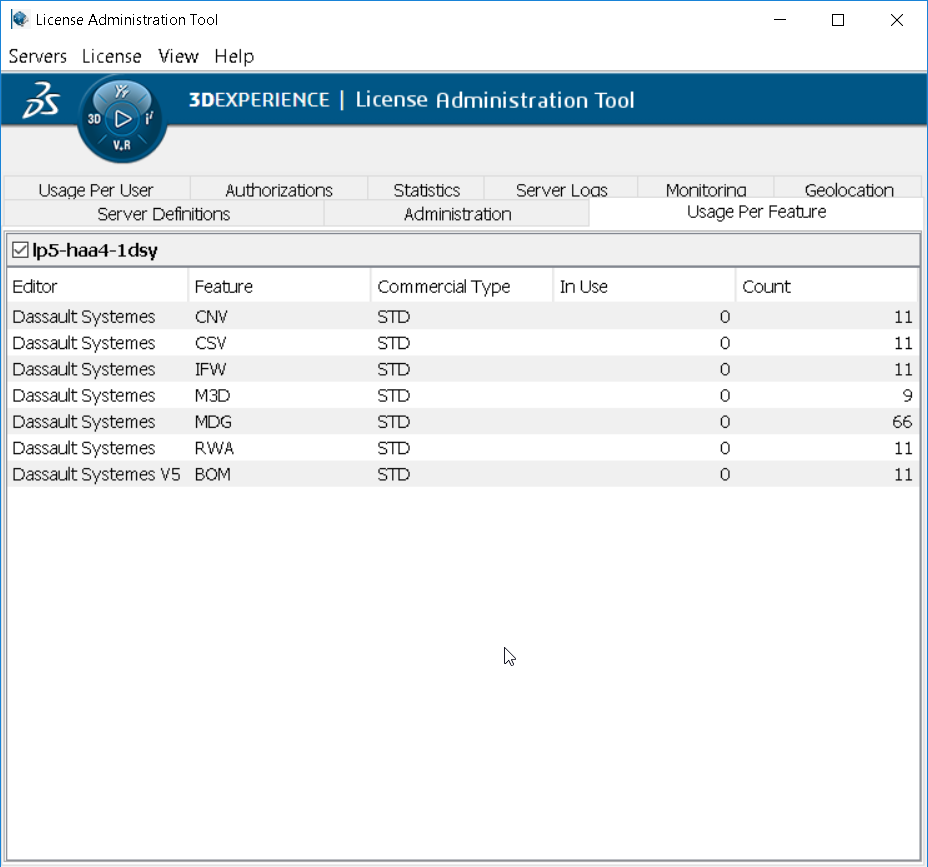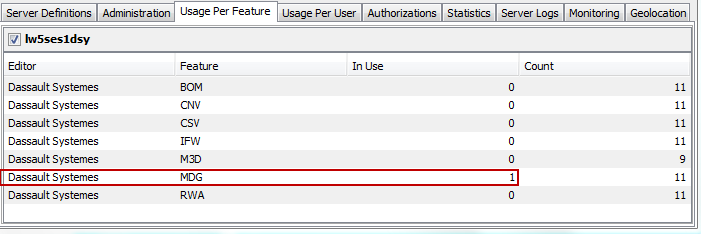-
Select to launch the License Administration Tool if it is
not already launched.
- Connect to the server.
- Click the Usage Per Feature tab.
Based on the licenses previously enrolled, the Usage Per Feature tab looks like this:

Click the column headers to sort them. If you want to sub-sort several columns, press the
Ctrl key while clicking. A tool tip is displayed on the vertical scrollbar to display the total number of lines and the range of lines displayed.
- Editor
-
Dassault Systemes, for example.
-
Feature
- Name of the app or custom configuration license. Keep in mind that the license can be
a named user license, a concurrent user license, a token license or a credit
license.
- Commercial Type
- Commercial types are:
- STD (for standard commercial licenses)
- DEMO (for demonstration licenses)
- EDU (for educational licenses).
- In use
- The number of licenses currently being used for a particular feature.
- Count
- Total number of licenses enrolled for a particular feature.
- Start a process (from the client or elsewhere) requiring a particular license.
In the remaining part of this section, the app license names are used for illustration
purposes only. When the license server grants the license, for example, to a license client, the In
Use column of a license displays the number of license used in the
Usage Per Feature tab:

- To find out details about the license consumed, double-click the line containing the corresponding license.
The Detailed License Usage box appears:

Time values displayed are formatted according to the local time (time zone) of the computer on which the License Administration Tool is running.
-
Server
-
Name of license server computer.
- License type
- Type of license: NamedUser, ConcurrentUser, Token or Credit.
- User
- User to whom the license is granted.
-
Host
-
Name of the client computer on which the licensed process is running.
- Granted since
-
Time and date at which the license was originally granted to the user.
- Last used at
-
Time and date at which the license was last used.
- Active process
Name of the active client process to which the license is granted. The prefix Offline is used to identify extracted offline licenses. Note that in the case of an application server process, the process name may not be displayed permanently. Set the following variable: MX_NUL_FULL_USAGE_REPORT=true in the enovia.ini file (Windows) or mxEnv.sh (Linux) to ensure that the process name is displayed. For more information about this variable, see the 3DSpace server documentation. - Granted at
- Time and date at which the license was granted to the current process(es).
- Max Release Number
- Feature release level authorized by the license. Only licensing clients having a release level lower or equal to this number are allowed. The
Max Release Number can be equal to 0. In this case, the license server does not perform any check related to release number: the license can be granted whatever the release level of the licensing client. - Expiration Date
- Date on which the granted license will expire. If expiring during a session, another license will be automatically granted (if possible). This field is empty for license server levels lower than R2015x.
- Max Release Date
- Client release date authorized by the license. Only licensing clients having a release date lower or equal to this number are allowed.
- Internal ID
- Reserved for internal use.
- Customer ID
- Customer id.
- Pricing Structure
-
The Pricing Structure defines the license (not
the license key) duration and support conditions, specified in the license contract. Examples of pricing structures are: - PLC: Primary License Charge
- TBL: Term-Based License charge
- ALC: Annual License Charge
- YLC: Yearly License Charge
- QLC: Quarterly License Charge
You may have different licenses with
different pricing structures for different usages.
- Process Code Release
If
there is an active process currently consuming a
license, this column displaying the client code process release level will be displayed as follows:

The value begins with "5" for V5 licensing client processes, and with "6" for V6 and 3DEXPERIENCE licensing client processes. - Active Session ID
- If there is an active process currently consuming a license, this column displays the ID described in field 4 of Usage Tracing from the server logs section.
- Casual usage (mn)
-
This field is only displayed once a casual license has been granted. It indicates, for the current month, the cumulative casual usage
for a given casual license, measured by the license server in minutes, as illustrated:

N/A is displayed in the field for full named
user licenses, indicating that this field is not applicable to full named
user licenses. The value in minutes is highlighted in red
if the maximum allowed usage duration is exceeded. Role of the License Server When the license server receives a
named user license request, it checks if it is for a full license
or a casual license. In the case of casual license, the license server then:
- measures
the monthly usage of casual usage named user licenses by named users
- compares
the monthly usages with maximum usage duration
- generates
monthly reports pointing the over-use (if any).
The license server measures usage
only for casual usage named user licenses. It does not measure usage of full named user licenses, concurrent user licenses, token licenses or credit licenses. In the event of license over-use, the following message is displayed in the casual usage log file: Usage of XXX (Dassault Systèmes) by YYY in excess of ZZZ mn and also in the Server Logs tab.
Note:
The month is managed as a calendar month between the 1st of month 00:00 UTC and the last day of month 24:00 UTC. The usage measurement is the same if the calendar month comprises 28, 29, 30 or 31 days or if it contains holidays.
Monthly Usage Reporting At the beginning of every calendar month,
the license server generates a usage report. This monthly report
file is generated only if at least one active casual usage named
user license is enrolled in the license server. It is generated
even if no over-use occurred during the calendar month. All casual usage values in Detailed License Usage dialog boxes on the license server are reset to "0" the following month.
The report is generated at 00h00 UTC. If the license server is not running at this particular moment, the report
is generated the next time the license server is restarted.
In case of failover, each member
generates the same report. The report files on each of the three members are the same. Please see File Locations, Settings and Registry Entries for a description of the report's location and contents.
- This time, start another app (for illustration purposes, LIV) and connect to a data source different from the 3DSpace server (you are not connected to the 3DSpace server), for example by opening a 3DXML file.
You will be prompted to choose the appropriate license using the Usage Per Feature tab. A license for the app is consumed, so the number in the In use column is incremented by 1. - To find out details about the license (who is using the license, what type license it is, etc.) double-click the line containing the appropriate license.
The Detailed License Usage box appears and looks like this (divided into three parts in the following screenshots): This is the left section showing the user:

and this section shows the active process:

You will find the same type of information (the license type is NamedUser), except that the user is not a named user (because you are not connected to the 3DSpace server ) but the operating system user. When you exit the session, therefore releasing the license, the number in the In use column becomes "0". - Then, start LIV-MDEVPM (for illustration purposes) and log on as DemoReviewer (this time, you are connected to the as a named user).
The LIV-MDEVPM license is a named user license. The number of LIV-MDEVPM licenses in use is now "1", and the number of IFW/CSV licenses in use is now "2" because when DemoReviewer consumes a LIV-MDEVPM license, an IFW/CSV license is also consumed. Note:
It may occur for a given feature that the numbers in the In use and the Count columns are identical. This means that no more license are available. When this is the case, the corresponding line is highlighted in bold.
- Double-click the line containing the LIV-MDEVPM license.
The Detailed License Usage box appears and looks like this:

- Which license is served to a client when several licenses match the client
request?
- A license key contains several fields. When a licensing client requests a license, it
passes several parameters to the license server, such as the feature name for
example.
When several licenses with different fields can satisfy the request, the
license server must decide which license will be granted. First, the license
server performs filtering based on the following criteria:
- the license must be active:
Start Date < current date < End
Date- the highest valid
Group Index is taken into
consideration.
- the remaining available quantity must be higher than 0
- the
Editor ("Dassault Systemes V5" for example) must match the
client request
- the
Feature (MD2 for example) must match the client request
- the
Model (ConcurrentUser for example) must
match the client request
- the
Max Release Number must be 0 or must be higher than or equal
to the Release Number passed by the client
- the
Max Release Date must be higher than or equal to the
Release Date passed by the client
- the
Commercial Type must match the client request (if
passed)
- the
Customer ID must match the client request (if passed)
- the
Pricing Structure must match the client request (if
passed)
- authorization rules (if any) must be satisfied.
Then, the license server performs sorting based on the following criteria:
Commercial Type: STD, then EDU, then DEMO- then,
Max Release Number: from the lowest to the highest (0 is
considered as infinite)
- then,
Max Release Date: from the lowest (the more distant in the
past) to the highest (the more distant in the future)
- then,
Additional Info:
- from the lowest number of fields to the highest number of fields
- then, from the lowest string to the highest string (locale alphanumeric
order).
- then,
End Date: from the highest (the more distant in the future)
to the lowest (the nearest in the future)
- then,
File Index: from the lowest to the highest (for a given
License ID)
- then,
Generation Date: from the highest (the less distant in the
past) to the lowest (the more distant in the past).
The license granted is the one on top of the filtered sorted list. When an
in-use license expires or belongs to a Group Index which becomes
superseded, the license server tries to silently grant another license, using the same
algorithm. If no license can be granted, the client will be informed at its next
heartbeat.
|







